Quicka
On this page, you find all documents, package deals, and flashcards offered by seller QuickA.
- 21
- 0
- 0
Community
- Followers
- Following
21 items
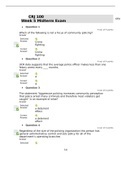
CRJ 100 Week 5 Midterm Exam Questions With Answers
Which of the following is not a focus of community policing? Answer Selected Answer: Crime fighting Correct Answer: Crime fighting Question 2 4 out of 4 points UCR data suggests that the average police officer makes less than one felony arrest every ____ months. Answer Selected Answer: 4 Correct Answer: 4 Question 3 4 out of 4 points The statement “Aggressive policing increases community perception that police arrest many criminals and therefore most violators get ...
- Exam (elaborations)
- • 172 pages •
Which of the following is not a focus of community policing? Answer Selected Answer: Crime fighting Correct Answer: Crime fighting Question 2 4 out of 4 points UCR data suggests that the average police officer makes less than one felony arrest every ____ months. Answer Selected Answer: 4 Correct Answer: 4 Question 3 4 out of 4 points The statement “Aggressive policing increases community perception that police arrest many criminals and therefore most violators get ...
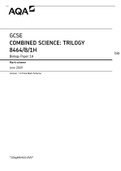
GCSE COMBINED SCIENCE: TRILOGY 8464/B/1H Biology Paper 1H 2020/21 100%approved
Marking of lists This applies to questions requiring a set number of responses, but for which students have provided extra responses. The general principle to be followed in such a situation is that ‘right + wrong = wrong’. Each error / contradiction negates each correct response. So, if the number of error / contradictions equals or exceeds the number of marks available for the question, no marks can be awarded. However, responses considered to be neutral (indicated as * in example 1...
- Exam (elaborations)
- • 20 pages •
Marking of lists This applies to questions requiring a set number of responses, but for which students have provided extra responses. The general principle to be followed in such a situation is that ‘right + wrong = wrong’. Each error / contradiction negates each correct response. So, if the number of error / contradictions equals or exceeds the number of marks available for the question, no marks can be awarded. However, responses considered to be neutral (indicated as * in example 1...
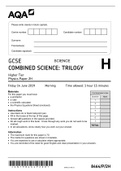
GCSE COMBINED SCIENCE: TRILOGY Higher Tier Physics Paper 2H paper 2019/20
GCSE COMBINED SCIENCE: TRILOGY Higher Tier Physics Paper 2H paper 2019/20
- Exam (elaborations)
- • 24 pages •
GCSE COMBINED SCIENCE: TRILOGY Higher Tier Physics Paper 2H paper 2019/20

BIOL 3311 - Test 2 Practice Test Study Guide - Fall 2020/21
Several sequences from different species that align to one another may be Homologous sequences, orthologous sequences 2. BLAST stands for Basic Local Alignment Search Tool 3. Two equal peaks, larger than the others, in a FinchTV chromatogram indicates Two of the bases can be ruled out as being located at that position 4. An acceptable E-value for a nucleotide sequence alignment is 1e-6 or less and identity of 70% or more 5. An acceptable E-value for an amino acid sequence alignment is 1...
- Exam (elaborations)
- • 5 pages •
Several sequences from different species that align to one another may be Homologous sequences, orthologous sequences 2. BLAST stands for Basic Local Alignment Search Tool 3. Two equal peaks, larger than the others, in a FinchTV chromatogram indicates Two of the bases can be ruled out as being located at that position 4. An acceptable E-value for a nucleotide sequence alignment is 1e-6 or less and identity of 70% or more 5. An acceptable E-value for an amino acid sequence alignment is 1...
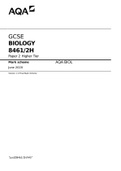
B2 2020 Higher Triple Biology MARK SCHEME
B2 2020 Higher Triple Biology MARK SCHEME
- Exam (elaborations)
- • 27 pages •
B2 2020 Higher Triple Biology MARK SCHEME
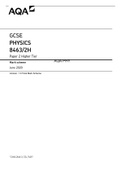
GCSE PHYSICS 8463/2H Paper 2 Higher Tier Mark scheme June 2020
GCSE PHYSICS 8463/2H Paper 2 Higher Tier Mark scheme June 2020
- Exam (elaborations)
- • 21 pages •
GCSE PHYSICS 8463/2H Paper 2 Higher Tier Mark scheme June 2020
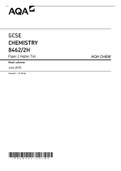
GCSE CHEMISTRY 8462/2H Paper 2 Higher Tier
This applies to questions requiring a set number of responses, but for which students have provided extra responses. The general principle to be followed in such a situation is that ‘right + wrong = wrong’. Each error / contradiction negates each correct response. So, if the number of error / contradictions equals or exceeds the number of marks available for the question, no marks can be awarded. However, responses considered to be neutral (indicated as * in example 1) are not penalise...
- Exam (elaborations)
- • 24 pages •
This applies to questions requiring a set number of responses, but for which students have provided extra responses. The general principle to be followed in such a situation is that ‘right + wrong = wrong’. Each error / contradiction negates each correct response. So, if the number of error / contradictions equals or exceeds the number of marks available for the question, no marks can be awarded. However, responses considered to be neutral (indicated as * in example 1) are not penalise...
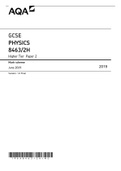
GCSE PHYSICS 8463/2H Higher Tier Paper 2 2019/20 100% MARKING SCHEME
This applies to questions requiring a set number of responses, but for which students have provided extra responses. The general principle to be followed in such a situation is that ‘right + wrong = wrong’. Each error / contradiction negates each correct response. So, if the number of error / contradictions equals or exceeds the number of marks available for the question, no marks can be awarded. However, responses considered to be neutral (indicated as * in example 1) are not penalise...
- Exam (elaborations)
- • 22 pages •
This applies to questions requiring a set number of responses, but for which students have provided extra responses. The general principle to be followed in such a situation is that ‘right + wrong = wrong’. Each error / contradiction negates each correct response. So, if the number of error / contradictions equals or exceeds the number of marks available for the question, no marks can be awarded. However, responses considered to be neutral (indicated as * in example 1) are not penalise...

GCSE COMBINED SCIENCE: TRILOGY 8464/C/2H Chemistry Paper 2H 202-2021 MARKING SCHEME
This applies to questions requiring a set number of responses, but for which students have provided extra responses. The general principle to be followed in such a situation is that ‘right + wrong = wrong’. Each error / contradiction negates each correct response. So, if the number of error / contradictions equals or exceeds the number of marks available for the question, no marks can be awarded. However, responses considered to be neutral (indicated as * in example 1) are not penalise...
- Exam (elaborations)
- • 19 pages •
This applies to questions requiring a set number of responses, but for which students have provided extra responses. The general principle to be followed in such a situation is that ‘right + wrong = wrong’. Each error / contradiction negates each correct response. So, if the number of error / contradictions equals or exceeds the number of marks available for the question, no marks can be awarded. However, responses considered to be neutral (indicated as * in example 1) are not penalise...
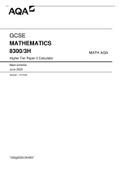
GCSE MATHEMATICS 8300/3H Higher Tier Paper 3 Calculator MARKING SCHEME 2020/21
GCSE examinations are marked in such a way as to award positive achievement wherever possible. Thus, for GCSE Mathematics papers, marks are awarded under various categories. If a student uses a method which is not explicitly covered by the mark scheme the same principles of marking should be applied. Credit should be given to any valid methods. Examiners should seek advice from their senior examiner if in any doubt. M Method marks are awarded for a correct method which could lead to a corr...
- Exam (elaborations)
- • 29 pages •
GCSE examinations are marked in such a way as to award positive achievement wherever possible. Thus, for GCSE Mathematics papers, marks are awarded under various categories. If a student uses a method which is not explicitly covered by the mark scheme the same principles of marking should be applied. Credit should be given to any valid methods. Examiners should seek advice from their senior examiner if in any doubt. M Method marks are awarded for a correct method which could lead to a corr...
